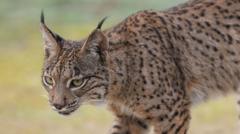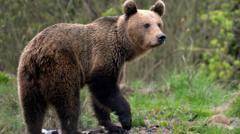After facing near extinction with numbers dwindling to fewer than 100, the Iberian lynx population has surged to over 2,000 thanks to dedicated conservation efforts in Spain and Portugal.
**The Iberian Lynx: A Symbol of Conservation Success in Spain and Portugal**

**The Iberian Lynx: A Symbol of Conservation Success in Spain and Portugal**
Efforts over the past decades have led to the remarkable recovery of the Iberian lynx population, once on the brink of extinction.
The Iberian lynx, known for its striking leopard-like spots, has become a rare yet increasingly visible presence in the wild thanks to a robust breeding and reintroduction program. The male lynx, named Navarro, was recently captured on camera following his mating call, an image that symbolizes the species' revival. "Twenty years ago, spotting one was almost impossible," notes Rodrigo Serra, who oversees lynx reproduction efforts in the region.
At the time of its most critical decline, the Iberian lynx had fewer than 100 individuals split into isolated populations, with only 25 females capable of reproduction. The threats to their survival included land conversion for agriculture, rising road fatalities, and a devastating 95% drop in their primary food source, wild rabbits, caused by two pandemics.
By 2005, the Iberian lynx had become extinct in Portugal. However, that same year marked a turning point as Spain successfully recorded its first litter of lynxes born in captivity. Portugal followed suit by establishing a National Conservation Plan, leading to the creation of a dedicated breeding center in Silves, Algarve.
At this breeding center, specialists like Serra carefully monitor the lynxes to condition them for life in the wild, ensuring they are adequately acclimated to their environment without forming associations with humans. This involved training the lynxes to be wary of humans, conditioning them to avoid populated areas for their safety.
After thorough preparation, juvenile lynxes are released into the wild, with careful genetic considerations to combat inbreeding. Pedro Sarmento, who has studied the lynx for three decades, emphasizes the importance of ensuring sufficient genetic diversity.
While the successful breeding program has resulted in growing lynx populations, the increased number of animals can create conflicts with local residents, especially regarding livestock. Conservationists have been proactive in addressing concerns, reinforcing chicken coops and monitoring lynx behavior to prevent encounters.
The journey of a lynx named Lítio illustrates the complexities involved in this conservation effort. Initially tracked after his release, he navigated his way back to Doñana National Park in Spain before ultimately settling closer to the Algarve after several releases. Lítio is now one of the oldest lynxes in the region, having successfully fathered numerous cubs.
Three decades after Spain initiated its conservation efforts, the Iberian lynx is no longer classified as endangered, and conservationists are hopeful for a sustainable population of 5,000-6,000 in the wild by 2035. Serra, reflecting on the journey, remarks on the surreal experience of witnessing these lynxes in their natural habitat, underscoring the successful collaboration between nations in wildlife conservation.
Despite the positive trajectory, concerns remain as 80% of lynx deaths still occur due to vehicular accidents. Nevertheless, the current outlook on the Iberian lynx symbolizes a significant conservation achievement for both Spain and Portugal.
At the time of its most critical decline, the Iberian lynx had fewer than 100 individuals split into isolated populations, with only 25 females capable of reproduction. The threats to their survival included land conversion for agriculture, rising road fatalities, and a devastating 95% drop in their primary food source, wild rabbits, caused by two pandemics.
By 2005, the Iberian lynx had become extinct in Portugal. However, that same year marked a turning point as Spain successfully recorded its first litter of lynxes born in captivity. Portugal followed suit by establishing a National Conservation Plan, leading to the creation of a dedicated breeding center in Silves, Algarve.
At this breeding center, specialists like Serra carefully monitor the lynxes to condition them for life in the wild, ensuring they are adequately acclimated to their environment without forming associations with humans. This involved training the lynxes to be wary of humans, conditioning them to avoid populated areas for their safety.
After thorough preparation, juvenile lynxes are released into the wild, with careful genetic considerations to combat inbreeding. Pedro Sarmento, who has studied the lynx for three decades, emphasizes the importance of ensuring sufficient genetic diversity.
While the successful breeding program has resulted in growing lynx populations, the increased number of animals can create conflicts with local residents, especially regarding livestock. Conservationists have been proactive in addressing concerns, reinforcing chicken coops and monitoring lynx behavior to prevent encounters.
The journey of a lynx named Lítio illustrates the complexities involved in this conservation effort. Initially tracked after his release, he navigated his way back to Doñana National Park in Spain before ultimately settling closer to the Algarve after several releases. Lítio is now one of the oldest lynxes in the region, having successfully fathered numerous cubs.
Three decades after Spain initiated its conservation efforts, the Iberian lynx is no longer classified as endangered, and conservationists are hopeful for a sustainable population of 5,000-6,000 in the wild by 2035. Serra, reflecting on the journey, remarks on the surreal experience of witnessing these lynxes in their natural habitat, underscoring the successful collaboration between nations in wildlife conservation.
Despite the positive trajectory, concerns remain as 80% of lynx deaths still occur due to vehicular accidents. Nevertheless, the current outlook on the Iberian lynx symbolizes a significant conservation achievement for both Spain and Portugal.




















